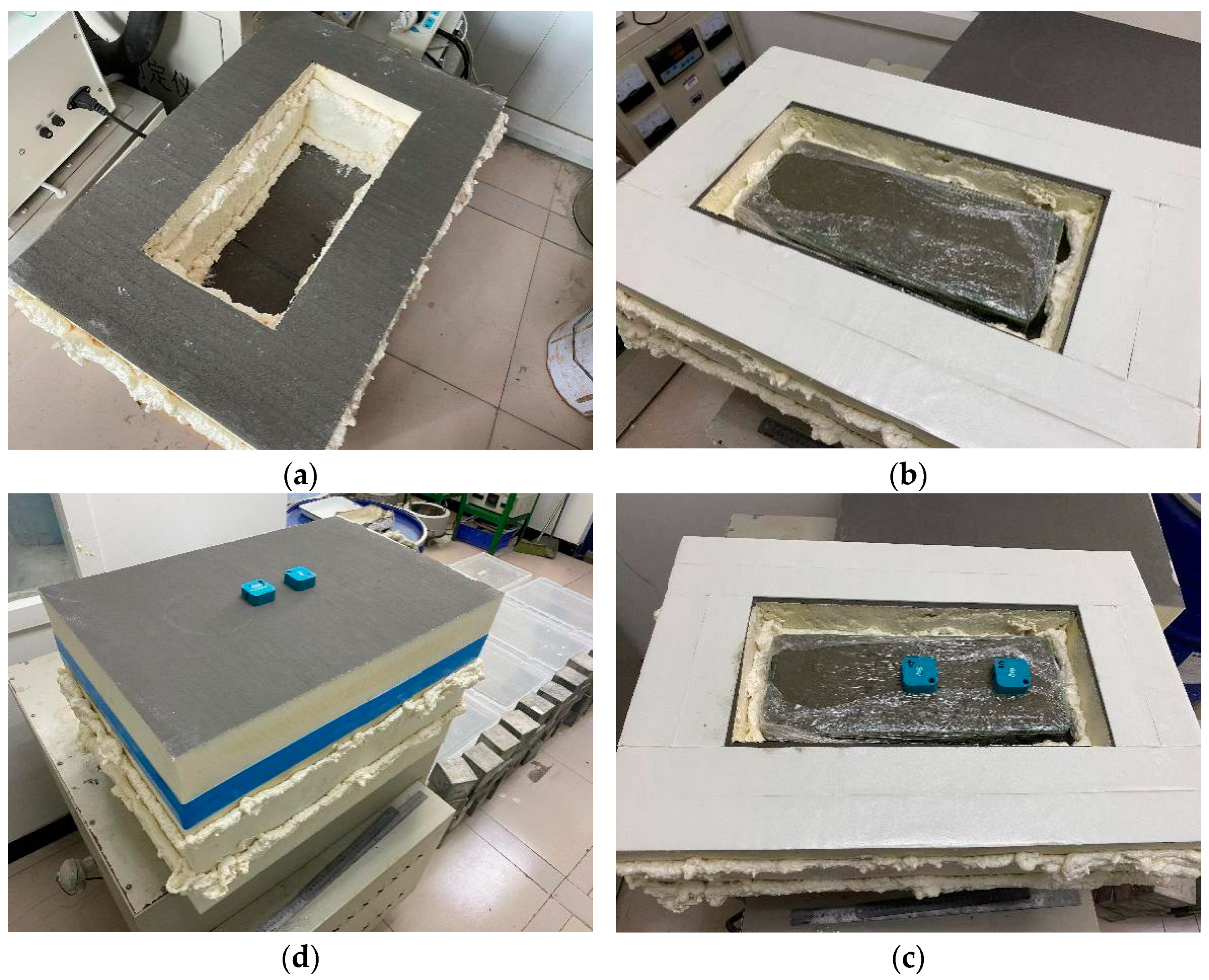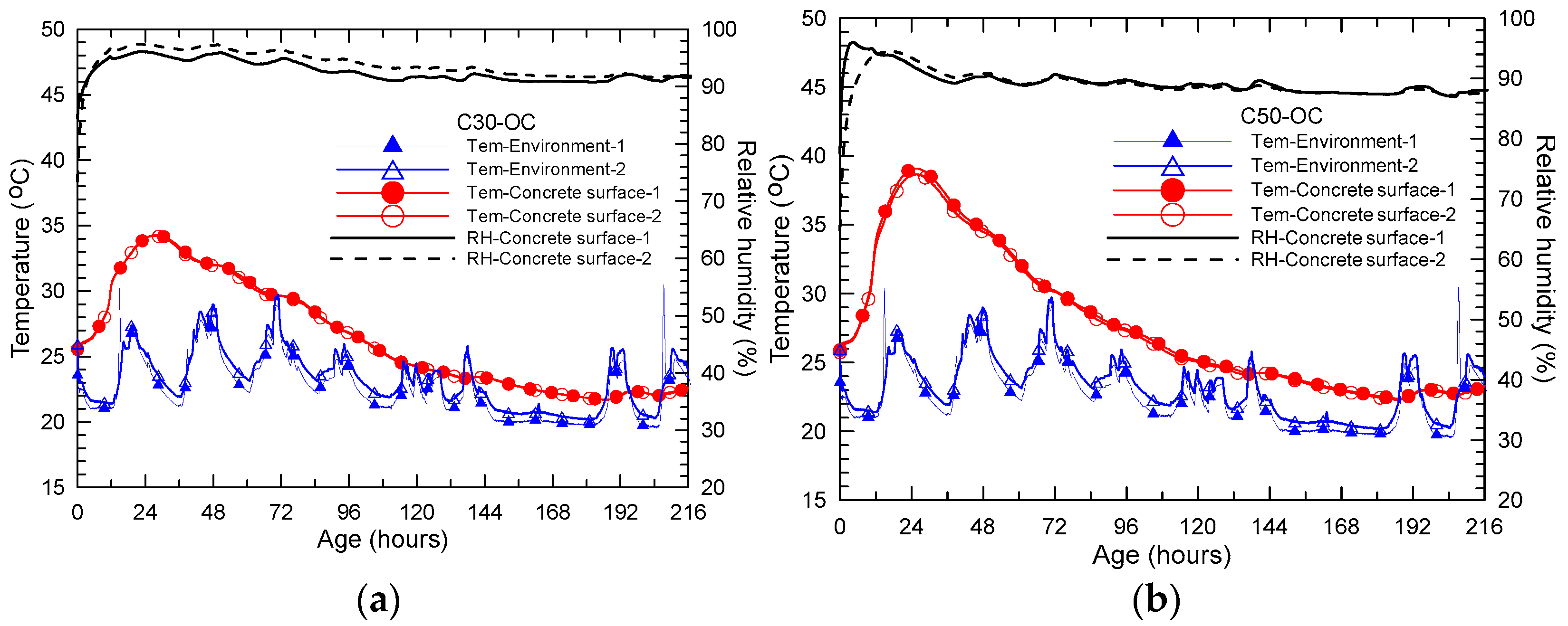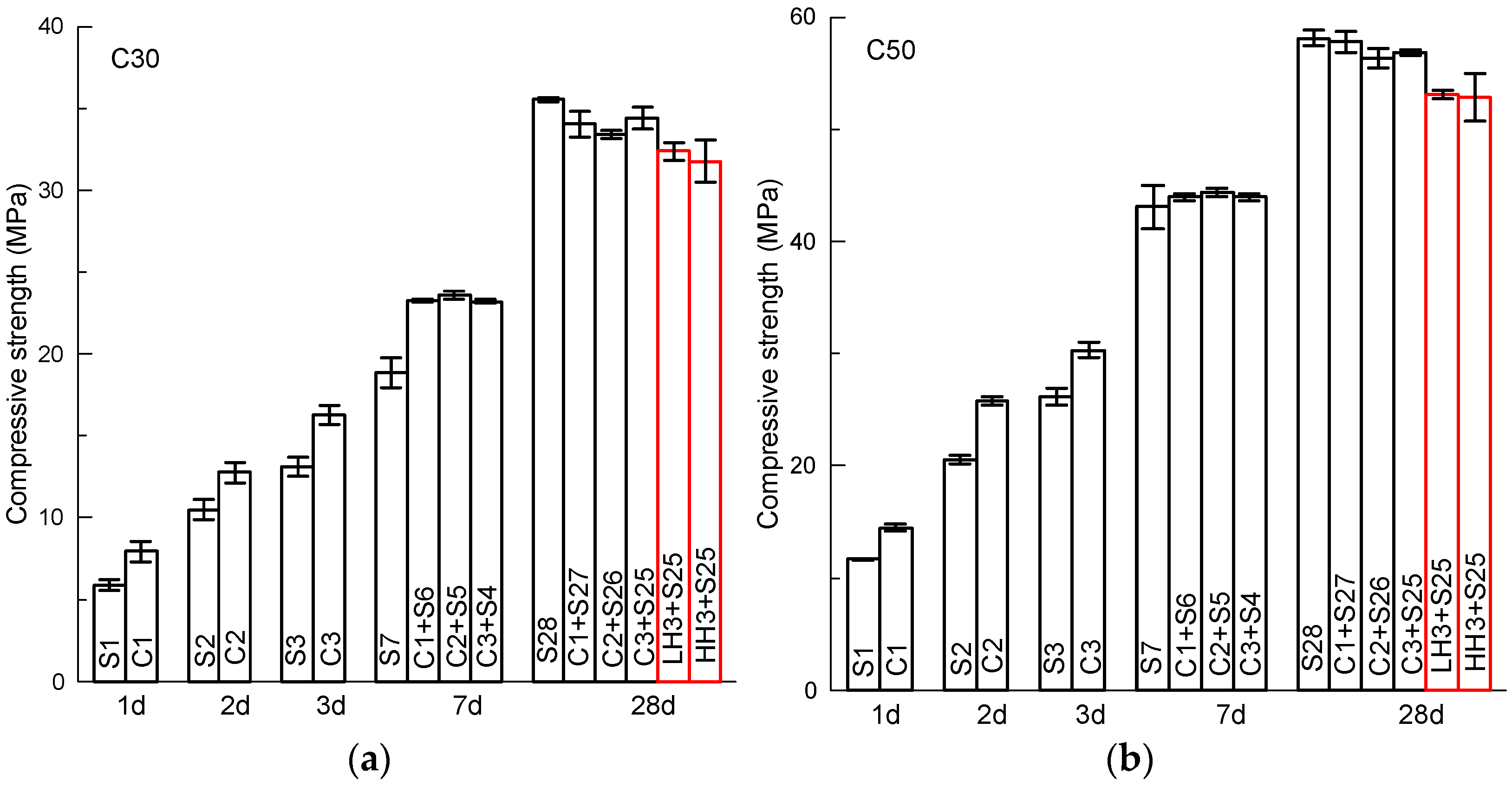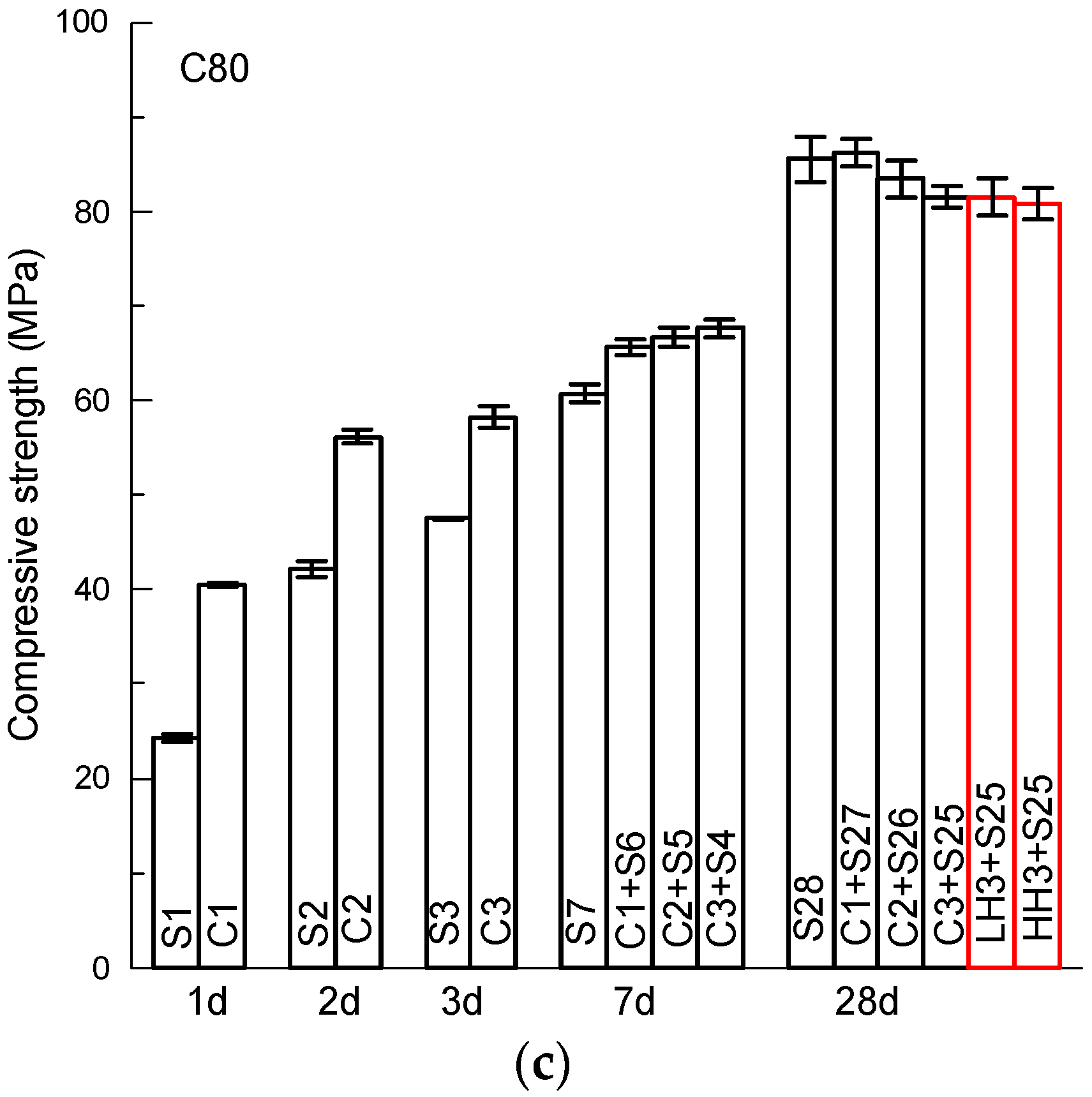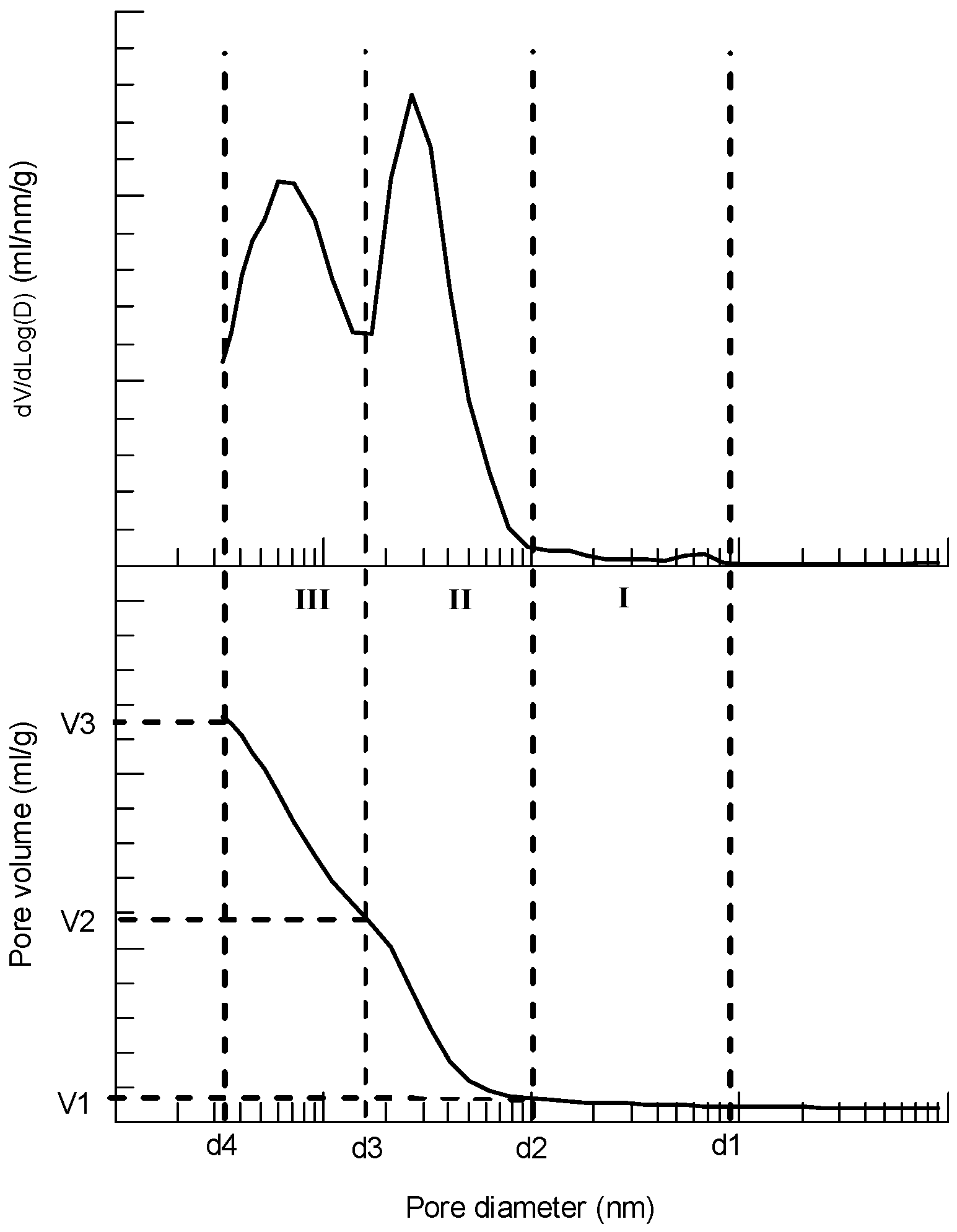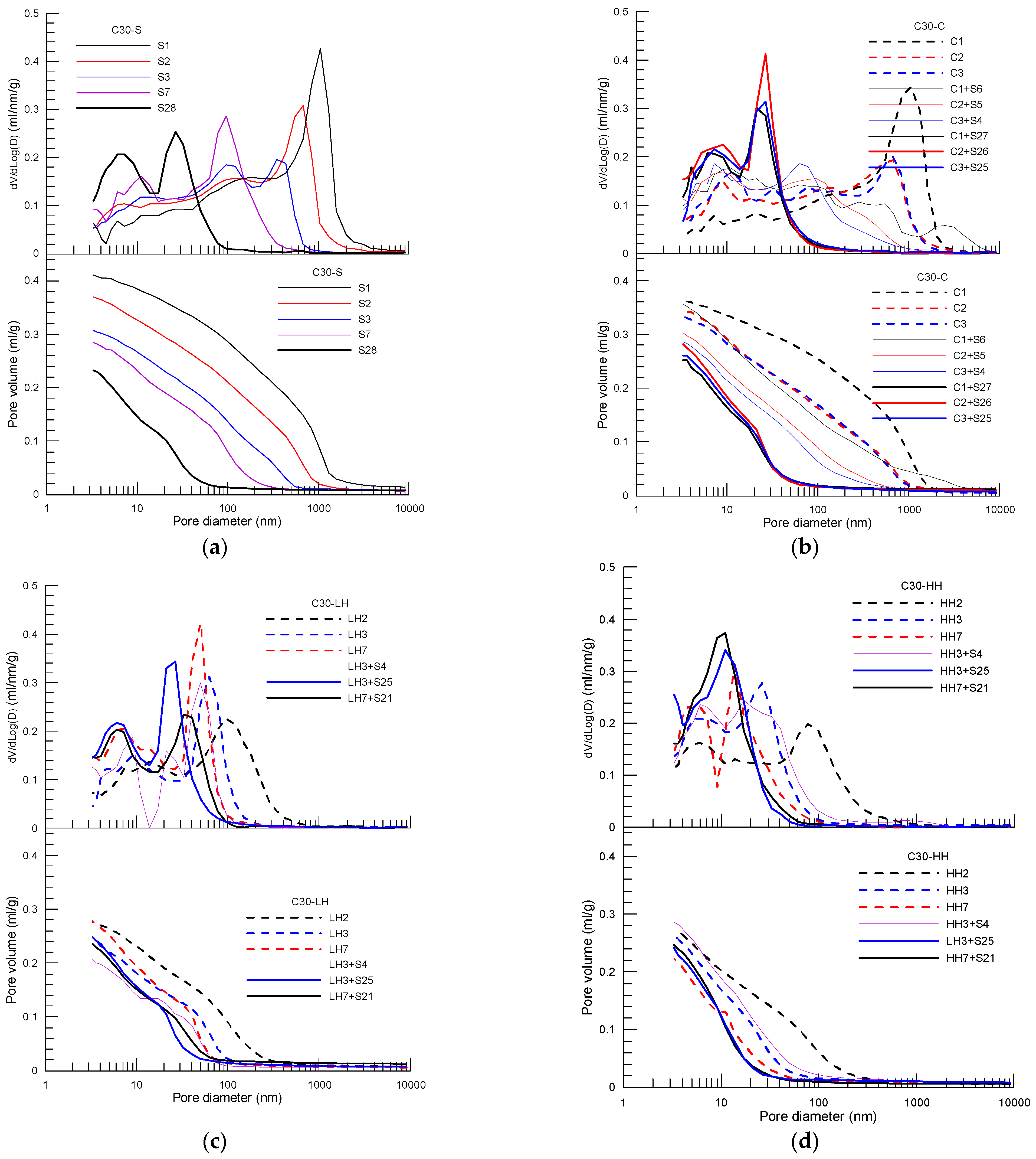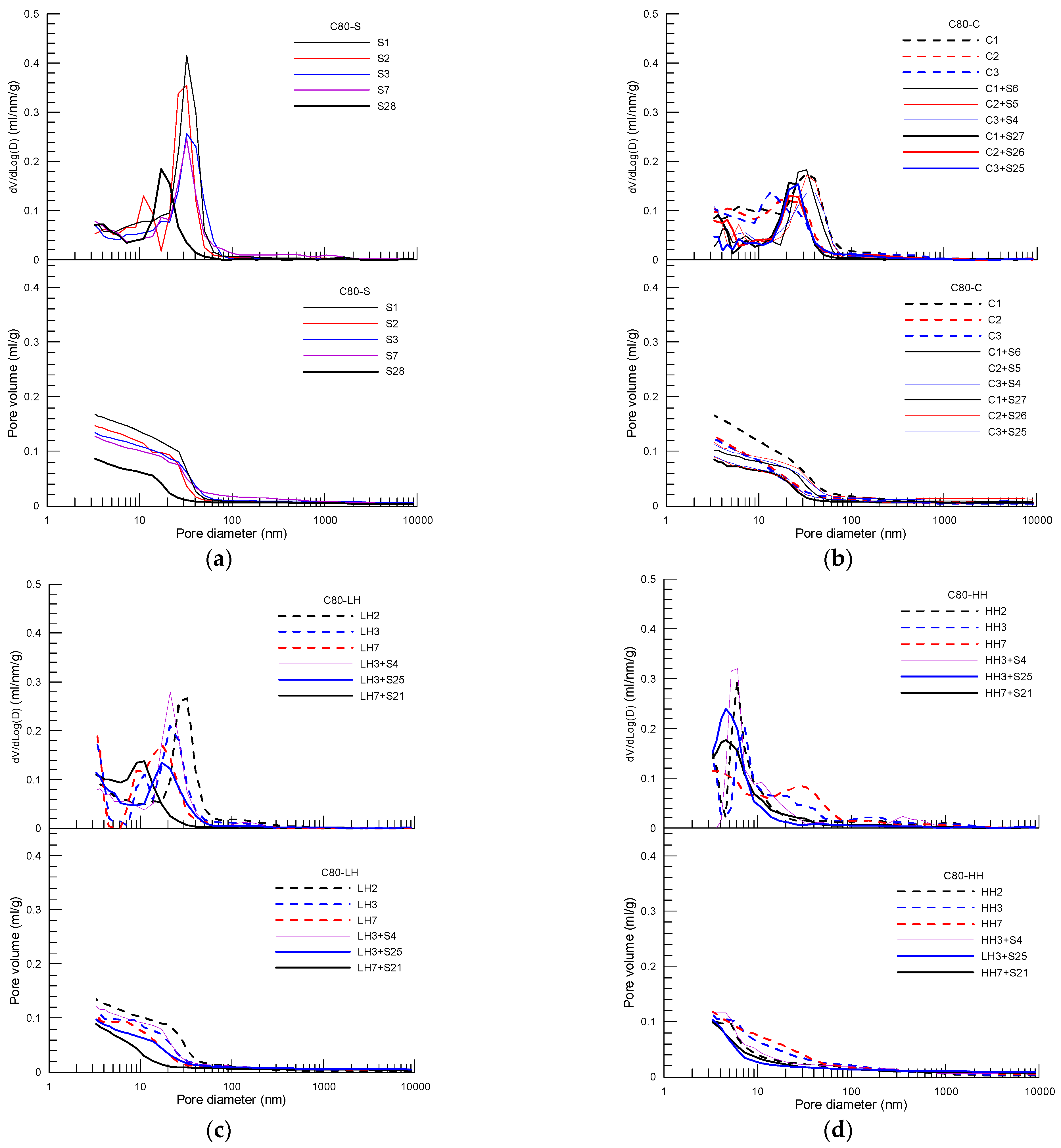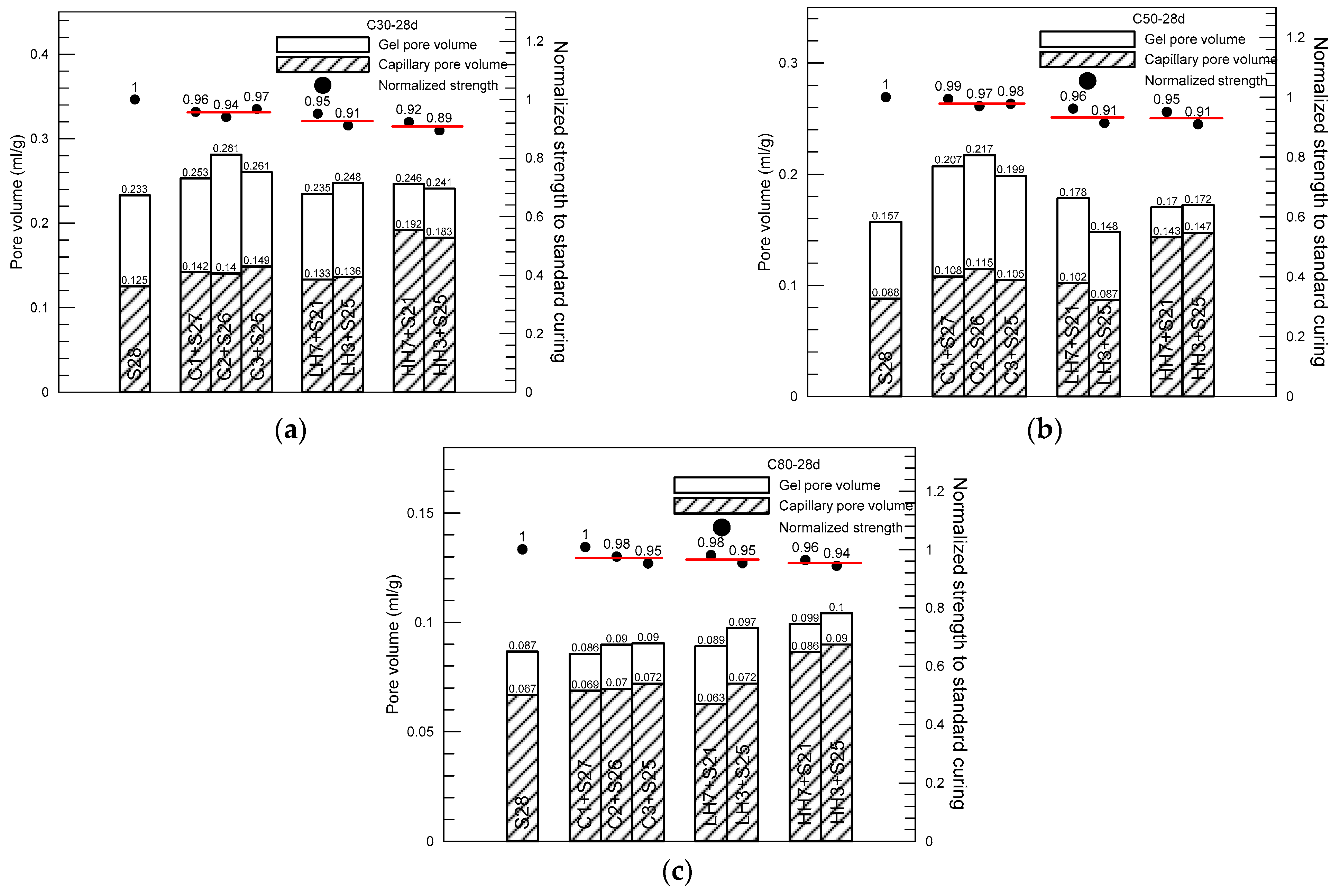3.2. Concrete Strength of Concrete under Insulation Curing
Now, it should be interesting to look at the effect of the temperature rise of concrete under insulation condition on the compressive strength of the concrete.
Figure 3 displays the compressive strength of concrete at different ages under the designed curing procedures of the present study, including standard curing (S), insulation cover curing (C) and heat curing (low temperature of 40 °C, LH; high temperature of 60 °C, HH). The number after the curing method in the legend of the figure is the corresponding age. It should be noted that only the strength at 28 days is presented for the concrete with constant temperature curing at its early age to study the possible damage of initial heating on concrete. In addition, the purpose of the increased number of testing ages as selected within the initial few days is to explore the possibility of insulation cover curing to replace traditional steam curing for fast remolding in pre-cast concrete pant.
From
Figure 3, it can be seen that after underdoing insulation curing, the compressive strength of concrete at an early age is obviously increased. The benefit of higher early age strength is obtained by simply putting an insulation caver on concrete specimens. For C30 concrete, compared with standard curing (S), the compressive strength is increased from 5.9 to 7.9 MPa (34%), 10.5 to 12.8 MPa (22%), 13.1 to 16.3 MPa (24%), respectively after insulation curing of 1, 2, 3 days. The data in brackets are the rates of increase based on standard curing. At 7 days, the strength of concrete subject to insulation curing is still higher than that of the specimens under standard curing. At 28 days, the compressive strength of concrete subject to insulation curing of 1, 2 and 3 days starting from concrete cast is 34.0 MPa, 33.4 MPa and 34.4 MPa, while the strength of concrete under standard curing is 35.5 MPa. The strength of the former is a bit lower than the latter. The reduction ratio is 4.2%, 5.9% and 3.1%, respectively, for insulation curing of 1, 2 and 3 days at the beginning. By contrast, compressive strength at 28 days of the specimens subject to 40 °C (2 days) and 60 °C (2 days) heat curing becomes 32.4 MPa and 31.8 MPa, respectively. The reduction ratio is 8.9% and 10.5%, which is obviously higher than that of the insulation curing. This means the present insulation curing can increase the early age strength, while the reduction in long term strength due to the initial short term heat curing can be decreased. This positive effect compared with traditional heat curing on concrete is clearly shown in
Figure 3a.
For C50 concrete (
Figure 3b), a similar trend in the compressive strength of concrete under different curing methods can be observed. Compared with standard curing (S), the compressive strength is increased from 11.7 MPa to 14.5 MPa (24%), 20.5 MPa to 25.8 MPa (26%), 26.1 MPa to 30.3 MPa (16%), respectively after insulation curing (C) of 1, 2, 3 days. As with C30 concrete, at 7 days, the strength of concrete subject to insulation curing is still higher than that of the specimens under standard curing. At 28 days, the compressive strength of concrete subject to insulation curing of 1, 2 and 3 days starting from concrete cast is 57.8 MPa, 56.4 MPa and 56.8 MPa, while the strength of the concrete under standard curing is 58.1 MPa. The strength of the former is a bit lower than that of the latter. The reduction ratio is 0.6%, 3.0% and 2.2%, respectively for insulation curing of 1, 2 and 3 days at the beginning. By contrast, the compressive strength at 28 days of the specimens subject to 40 °C (2 days) and 60 °C (2 days) heat curing becomes 53.1 MPa and 52.8 MPa, respectively. The reduction ratio is 8.6% and 9.1%, which are obviously higher than that of the insulation curing.
For C80 concrete (
Figure 3b), compared with standard curing (S), the compressive strength is increased from 24.3 to 40.5 MPa (67%), 42.2 to 56.1 MPa (33%), 47.5 to 58.2 MPa (23%), respectively after insulation curing (C) of 1, 2, 3 days. Similar to C30 and C50, at 7 days, the strength of the concrete subject to insulation curing is still higher than that of the specimens under standard curing. At 28 days, the compressive strength of concrete subject to insulation curing of 1, 2 and 3 days starting from concrete cast is 86.2 MPa, 83.4 MPa and 81.4 MPa, while the strength of the concrete under standard curing is 85.5 MPa. Clearly, the concrete subject to 1-day insulation curing has slightly higher compressive strength than the concrete under standard curing, although the rate of increase is only 0.8%. The other two curing procedures, 2 and 3-day insulation curing, display decreasing compressive strength compared with that of standard curing. The rate of decrease is 2.5% and 3.2%, respectively for 2 and 3-day insulation curing. By contrast, the compressive strength at 28 days of the specimens subject to 40 °C (2 days) and 60 °C (2 days) heat curing becomes 81.5 MPa and 80.7 MPa, respectively. The reduction ratio is 4.7% and 5.6%, respectively for the 40 °C and 60 °C 2-day initial curing.
From the test results showed in
Figure 3, it can be concluded that very early-age strength (within the initial 3 days after casting) of concrete can be increased by simply putting on an insulation cover of polyurethane boards. Cement hydration heat can be used for curing concrete, and it should be an increasing choice for reducing or replacing steam curing in pre-cast concrete plants. The rate of increase in early-age strength of insulation curing is influenced by the concrete strength grade or water to binder ratio of the concrete. On the other hand, a negative effect of heat curing on the concrete strength in the long term is observed as well. This phenomenon is observed as well in previous studies [
2,
5,
17,
18,
19]. The reduction rate is influenced by the listing time of the insulation curing and concrete strength. Based on the present study, the shorter the insulation curing period, the more the reduction on long-term strength is reduced. A rational period of heat curing should be selected based on the requirements of early-age strength and long-term performance. The mechanism of the effect of curing temperature on concrete strength should be discussed in the following section based on pore structure measurement, in turn based on the mercury intrusion method.
3.3. Pore Structures of Concrete under Different Curing Procedures
Mercury intrusion porosimetry is a widely used technique to evaluate the pore structures of cementitious materials, including pore size distribution and pore volume fraction.
Figure 4 shows a typical pore distribution in terms of cumulative (below) and derivative (above) pore volume versus pore diameter based on MIP of the cement paste of C30 concrete. It should be noted that the pore size here refers to percolation size of the pore corresponding to the intruded pressure of mercury. Although the pores in cement paste may be not ideal round tubes, pore size or diameter measured by MIP can well be used to reflect the equivalent pore size in the paste. From
Figure 4, the process of mercury intrusion into cement paste can roughly be divided into three stages according to the rate of the intrusion (dV/dLogD): stage I—initial slow increase stage, relatively large pore diameter variation with small increase in pore volume, the corresponding diameter boundary is (d1, d2) and the pore volume at end of this stage is V1; stage II–rapid increase stage (first peak of dV/dLogD), relatively small pore diameter variation with relatively large increase in pore volume, the corresponding diameter boundary is (d2, d3) and the pore volume at end of this stage is V2; stage III–relatively fast increase stage (second peak of dV/dLogD, normally smaller than the first peak), relatively large pore diameter variation with relatively large increase in pore volume, the corresponding diameter boundary is (d3, d4) and the pore volume at end of this stage is V3. The main contribution of the pores in stage I can be assumed as small amount of gas pores and/or relatively larger capillary pores due to mixing of the fresh paste. For stage II, the contribution of the pores should be the principal amount of the capillary pores, and the ascending and descending of the pore volume rate (dV/dLogD) should be the balance between the number and diameter of the pores. In stage III, the main contribution of the pores should be micropores of C-S-H gel plus a small amount of the capillary pores with narrow size. Therefore, the volume of capillary pore volume can be estimated by V2, and the gel pore volume can be estimated by (V3–V2). A similar classification was used as well by Bahafid et al. [
6] for pore characteristic evaluation of well cement under different hydration temperatures. According to the above division method, the effects of different curing procedures on pore structures of the cement paste of C30, C50 and C80 concrete are analyzed below.
Figure 5,
Figure 6 and
Figure 7 present pore distribution of the cement pastes subject to different curing procedures designed by the present study in terms of cumulative (below) and derivative (above) pore volume versus pore diameter based on MIP of C30, C50 and C80 concrete, respectively. Again, the number after the curing method shown in the legend is the corresponding age. As an example, pore structure of the cement paste of C30 concrete under different curing procedure is analyzed first in the following.
From
Figure 5a, the variation law of pore distribution of the cement paste of C30 concrete under standard curing is clearly shown. A two-peak mode of pore volume rate of increase is observed in the derivative curves. Correspondingly, a two-stage mode of pore volume development is observed as well in the cumulative curves. In stage I, the pore volume (V1) is similar for all pastes cured at different curing age, and d2 is gradually moved forward to the direction of smaller pore size with the increase in curing age. In stage II, the rate peak is gradually moved forward to the smaller pore direction, and the peak value is decreased with the increase in curing age. Correspondingly, the pore volume of V2 and the boundary pore size of diameter d3 are reduced with age due to hydration of the cement. In stage III, corresponding to the second mercury intrusion perk, the pore volume of V3 is significantly decreased with increase in curing age. At 28 days, the total pore volume of the paste of C30 concrete under standard curing is 0.233 mL/g, and the corresponding capillary pore (V2) and gel pore (V3–V2) volumes are 0.125 mL/g (53.6% of the total pore) and 0.108 mL/g (46.4% of the total pore). The pore size of d3 is 13.72 nm which is close to the low limit (about 10 nm) of the general definition of capillary pore in cement paste [
20].
Under insulation curing, see
Figure 5b, first, a similar pattern of pore distribution of the cement paste subject to insulation curing is observed compared with that of standard curing. The two-peak mode (derivative curve) and two-stage mode (cumulative curve) is obvious. This similarity indicates the present insulation cover curing performed at very early-age (within 3 days) and does not make and obvious change in the pore structures of the cement paste according to the classification shown in
Figure 4. Second, as expected, within the initial three days of insulation curing, the pore volume of the paste is decreased compared with that of the paste under standard curing at the same age. This is consistent with the increase in compressive strength of the concrete after insulation curing. However, at 28 days, the pore volume of the paste subject to insulation curing is increased a little compared with that of standard curing. The total pore volume at 28 days is 0.2530, 0.2812 and 0.2605 mL/g, respectively, of the paste subject to 1, 2 and 3 days insulation curing, respectively. The corresponding pore volume at 28 days of standard curing is 0.2330 mL/g. This indicates that the rising curing temperature (below 35 °C, see
Figure 2a) leads to an increase in porosity of the cement paste. Third, according to the classification shown in
Figure 4, at 28 days, the capillary pore (V2) and gel pore (V3–V2) volume of the pastes subject to 1, 2 and 3 days insulation in the initial period after casting are (0.142, 0.111); (0.141, 0.141) and (0.149, 0.112) mL/g, respectively. The pore size of d3 is 13.73, 17.1 and 13.72 nm, respectively, which is comparable to that of standard curing.
From the pore distribution result of the paste subject to a constant temperature of 40 °C (LH) in the initial few days after casting (
Figure 5c), first, a similar variation pattern to the paste cured under standard (
Figure 5a) and insulation curing (
Figure 5b) is found. The two-peak mode in the derivative curve and/or two-stage mode in the cumulative curve is displayed. Second, at 28 days, the pore volume of the paste subject to LH curing is increased a little compared to that of standard curing, while it is decreased a little compared to that of insulation curing. The total pore volume at 28 days is 0.2348 mL/g and 0.2476 mL/g, respectively, for the paste subject to 2 days heat curing plus 26 days standard curing (2LH + 26S) and 6 days heat curing plus 22 days standard curing (6LH + 22S). The corresponding pore volume is 0.2330 mL/g, and 0.2530, 0.2812, 0.2605 mL/g for the paste at 28 days under standard curing and insulation curing of 1, 2, 3 days initially that was labeled as (C3 + S25), (C2 + S26), (C1 + S27) in the figures. It should be noted that the total pore volume of the paste after LH curing is lower than that of the paste subject to insulation curing; however, the compressive strength of the concrete subject to LH curing is still lower than the concrete with insulation curing, see
Figure 3a. Third, at 28 days, the capillary pore (V2) and gel pore (V3–V2) volume of the pastes subject to 2 and 6 days LH curing in the initial period after casting are (0.136, 0.112) and (0.133, 0.102) mL/g, respectively. The pore size of d3 is 13.72 and 13.73 nm, respectively, which is comparable to that of standard curing too.
As the curing temperature rises to 60 °C (HH), see
Figure 5d, first, as expected, the first peak of pore volume variation moves forwards to the direction of the small pore size, and pore volume is decreased compared with the corresponding age of standard curing. A more interesting observation is that with the increase in age, the two derivative peaks are gradually combined together to form a single wider and higher peak, for example at 28 days. This means the stage II and stage III occurring in the cumulative curve is combined together (the slope of the stage III is increased and almost equal to that of stage II). Second, at 28 days, the same as the paste under LH curing, the pore volume of the paste subject to HH curing is increased a little compared to that of standard curing. The total pore volume at 28 days is 0.2464 mL/g and 0.2410 mL/g, respectively, for the paste subject to 2 days heat curing plus 25 days standard curing (3HH + 25S) and 6 days heat curing plus 21 days standard curing (7HH + 21S). However, at 28 days, the capillary pore (V2) and gel pore (V3–V2) volume of the pastes subject to 2 and 6 days HH curing in the initial period after casting are (0.183, 0.058) and (0.192, 0.055) mL/g, respectively. The pore size of d3 becomes about 6.03 nm, which is much smaller than that of standard, insulation and HH curing. Clearly, the volume fraction of the capillary pores is obviously increased for the paste subject to HH curing initially, from 54% to 76% of standard curing to HH curing. The third group of the pore volume (mainly composed of C–S–H gel pores) is greatly decreased (from 46% to 24% of the total pore volume of standard curing to HH curing), although the total pore volume is still comparable to that of standard curing. Principally, formation of denser C-S-H gel with less gel porosity is responsible for the above significant change in the pore composition of cement paste under HH curing (60 °C).
A similar observation was presented as well in a previous studies; for example, Bahafid [
6] found an increase in the capillary porosity and a decrease in the gel porosity by increasing the hydration temperature of well cement paste, especially when the curing temperature is equal to or above 60 °C. This is attributed to a decrease in the C–S–H gel intrinsic porosity and a corresponding increase in C–S–H density for higher curing temperature [
6,
21,
22].
For pastes of C50 concrete (
Figure 6) and C80 (
Figure 7), a similar variation trend in pore structure, as found as in the paste of C30, is observed for pastes under different curing procedures. The pore characteristic parameters, including total pore volume, capillary pore volume and gel pore volume, as well as the corresponding pore size, are obtained for pastes of C50 and C80 concrete using the method described above.
Figure 8a to
Figure 8c summarize the pore composition of the pastes of C30, C50 and C80 concrete at 28 days under the four curing procedures (S, C, LH, HH), respectively, in which three curing procedures of insulation curing, C1 + S27, C2 + S26, C3 + S25, and two curing procedures of LH and HH, LH7 + S21, LH3 + S25 and HH7 + S21, HH3 + S25 are included. In addition, normalized average compressive strength with respect to the strength of standard curing is displayed as well to explore the correlation between strength reduction and the curing method used in the initial period after casting. The red line shows the average normalized strength of each curing procedure.
From the pore composition data listed in
Figure 8a, first, it can clearly seen that the total pore volume of the paste of C30 concrete is slightly increased after being subject to insulation curing (C), heat curing with relative low temperature (LH) and heat curing with relative high temperature (HH) in the initial period after casting of the concrete compared to that of standard curing (S). Among them, the increase in pore volume of insulation curing group is the highest. However, the reduction in compressive strength at 28 days compared with that of standard curing is the smallest among the three heat curing procedures. This means the total pore volume of the cement paste cannot simply correlate to the macro strength of the concrete in the present case. Second, on the effect of curing procedure on the capillary pore volume of the paste, it can be clearly seen that the capillary pore volume of the paste is monotonously increased from standard curing (20 °C), insulation curing (varied temperature and above 20 °C), low temperature heat curing (40 °C) and high temperature heat curing (60 °C). Especially, for the HH curing, the increase in capillary pore volume is more remarkable than the rest of the heat curing procedures. This variation trend in the capillary pore volume is consistent with the compressive strength of the concrete, although more influencing factors should be involved when concrete strength is considered. The reasons for the strength reduction at 28 days of the concrete subject to heat curing may include not only the effect of pore structure of the paste, but the influence of non-uniform deformation occurring in concrete, especially along the aggregate/matrix interface under varied temperature history within concrete, should be included as well. More detailed studies on the effect of short-term heat curing on long-term mechanical properties of concrete, not only on the microstructure of the cement paste, but also on macro non-uniform deformation of concrete, are continuously needed.
A quite similar variation trend in the pore composition of the paste of C50 concrete at 28 days under the four curing procedures, see
Figure 8b, is observed. First, the total pore volume of the paste of C50 concrete is increased as well after being subject to insulation curing (C), heat curing with relative low temperature (LH) and heat curing with relative high temperature (HH) in the initial period after casting of the concrete compared to that of standard curing (S). As observed in the paste of C30 concrete, the highest increase in pore volume occurred among the curing group of insulation cover curing. However, the reduction in compressive strength at 28 days compared with that of standard curing is the smallest among the three heat curing procedures and is even smaller than that of C30 concrete. Second, the capillary pore volume of the paste is increased as well from standard curing, insulation curing, low temperature heat curing (40 °C) and high temperature heat curing (60 °C). As the paste subject was to higher temperature curing initially (HH), the increase in capillary pore volume is significant relatively. Overall, the variation trend in the capillary pore volume is consistent with the compressive strength of the concrete. For the paste of C80 concrete, see
Figure 8c, the total pore volume displays a gradual increasing trend following the order of standard curing (S), insulation curing (C), heat curing with relative low temperature (LH) and heat curing with relative high temperature (HH). This differs from that of C30 and C50 concrete. The capillary pore volume of the paste is increased accordingly, and the increasing amount is relatively obvious as high temperature heat curing (HH) is used. Although the strength reduction due to heat curing is in agreement with the capillary pore content, an exception such as high temperature heat curing is noticeable.
By comparing the results displayed in
Figure 8, it can be concluded that the effect of initial curing (increasing curing temperature) used in the initial period after concrete casting on the pore structure of the cement paste mainly presented as the increase in capillary pore fraction. Among the four curing methods used in the present study, the effect of insulation cover curing and low temperature (40 °C) heat curing on the capillary pore content is small compared with that of standard curing, while the effect of high temperature (60 °C) heat curing is significant. This is observed not only in the measurement of the paste of C30 concrete, but also in that of C50 and C80 concrete. This finding may help to understand the effects of heat curing in the initial period after concrete casting on the long-term performance of concrete, and further may help to improve the curing method normally used in pre-casting plants in order to increase very early-age strength of the pre-cast concrete. Obviously, the suggested insulation cover curing is of obvious advantage compared to the traditional heat curing, not only in relation to the cost of pre-cast concrete production, but also in relation to the improvement of long-term performance of concrete.
